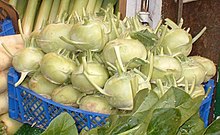Kohlrabi
| Kohlrabi | |
|---|---|
 Kohlrabi stems with leaves removed | |
| Species | Brassica oleracea |
| Cultivar group | Gongylodes Group |
| Cultivar group members | many; see text |
| Nutritional value per 100 g (3.5 oz) | |||||||||||||||||
|---|---|---|---|---|---|---|---|---|---|---|---|---|---|---|---|---|---|
| Energy | 113 kJ (27 kcal) | ||||||||||||||||
6.2 g | |||||||||||||||||
| Sugars | 2.6 g | ||||||||||||||||
| Dietary fiber | 3.6 g | ||||||||||||||||
0.1 g | |||||||||||||||||
1.7 g | |||||||||||||||||
| |||||||||||||||||
| Other constituents | Quantity | ||||||||||||||||
| Water | 91 g | ||||||||||||||||
| †Percentages estimated using US recommendations for adults,[1] except for potassium, which is estimated based on expert recommendation from the National Academies.[2] | |||||||||||||||||
- "Gonglyodes" redirects here. For the moth genus of that name, see Erechthias.
Kohlrabi (German turnip) (Brassica oleracea Gongylodes group) is a perennial vegetable, and is a low, stout cultivar of cabbage.
The name comes from the German Kohl ("cabbage") plus Rübe ~ Rabi (Swiss German variant) ("turnip"), because the swollen stem resembles the latter, hence its Austrian name Kohlrübe. Kohlrabi is a very commonly eaten vegetable in German speaking countries.
Kohlrabi has been created by artificial selection for lateral meristem growth (a swollen, nearly spherical shape); its origin in nature is the same as that of cabbage, broccoli, cauliflower, kale, collard greens, and Brussels sprouts: they are all bred from, and are the same species as the wild cabbage plant (Brassica oleracea).
The taste and texture of kohlrabi are similar to those of a broccoli stem or cabbage heart, but milder and sweeter, with a higher ratio of flesh to skin. The young stem in particular can be as crisp and juicy as an apple, although much less sweet.

Except for the Gigante cultivar, spring-grown kohlrabi much over 5 cm in size tend to be woody, as do full-grown kohlrabi much over perhaps 10 cm in size; the Gigante cultivar can achieve great size while remaining of good eating quality. The plant matures in 55–60 days after sowing. Approximate weight is 150 g and has good standing ability for up to 30 days after maturity.
Kohlrabi can be eaten raw as well as cooked.
There are several varieties commonly available, including White Vienna, Purple Vienna, Grand Duke, Gigante (also known as "Superschmelz"), Purple Danube, and White Danube. Coloration of the purple types is superficial: the edible parts are all pale yellow. The leafy greens can also be eaten.

Some varieties are grown as feed for cattle.[3]
Kohlrabi is one of the most commonly eaten vegetables in Kashmir.[citation needed] Locally called monj, the vegetable is eaten along with the leaves (haakh). A Kashmiri household may have this on their dinner or lunch plates three to four times a week.[citation needed] Monj (kohlrabi) is made in many forms. There is a spicy version which the Pandits call dum monj, while as the nonspicy version is called monj-haakh.[citation needed]
In India, Kohlrabi is more commonly called Knolkhol (English) or Nookal (Hindi). It is also used extensively in Southern part of India. In Kannada, Kohlrabi is called Gedde Kosu or Navilu Kosu.
Preparation
Kohlrabi stems are surrounded by two distinct fibrous layers that do not soften appreciably when cooked. These layers are generally peeled away prior to cooking or serving raw, with the result that the stems often provide a smaller amount of food than one might assume from their intact appearance.
Kohlrabi leaves are edible and can be used interchangeably with collard and kale.
References
- ^ United States Food and Drug Administration (2024). "Daily Value on the Nutrition and Supplement Facts Labels". FDA. Archived from the original on 2024-03-27. Retrieved 2024-03-28.
- ^ National Academies of Sciences, Engineering, and Medicine; Health and Medicine Division; Food and Nutrition Board; Committee to Review the Dietary Reference Intakes for Sodium and Potassium (2019). Oria, Maria; Harrison, Meghan; Stallings, Virginia A. (eds.). Dietary Reference Intakes for Sodium and Potassium. The National Academies Collection: Reports funded by National Institutes of Health. Washington, DC: National Academies Press (US). ISBN 978-0-309-48834-1. PMID 30844154. Archived from the original on 2024-05-09. Retrieved 2024-06-21.
- ^ Bailey, L. H., (1912, republished in 1975). Kohlrabi for stock-feeding. In Cyclopedia of American Agriculture: Vol. II--crops. Macmillan Publishing, New York. p. 389-390. ISBN 0-405-06762-3. Google Book Search. Retrieved on June 15, 2008.
External links
- PROTAbase on Brassica oleracea (kohlrabi)
- Horticultural information on the tasty kohlrabi From the Learn2Grow databases
- Kohlrabi and Brussels Sprouts Are European
 Texts on Wikisource:
Texts on Wikisource:
- "Kohl-rabi". Encyclopedia Americana. 1920.
- Gilman, D. C.; Peck, H. T.; Colby, F. M., eds. (1905). New International Encyclopedia (1st ed.). New York: Dodd, Mead.
{{cite encyclopedia}}: Missing or empty|title=(help)
